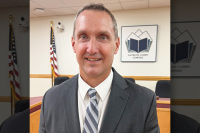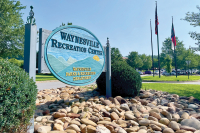Listening to the stone
By Michael Beadle
A goddess rises through ribbons of translucent alabaster. A pair of doves flutters from bronzed hands. An old, wizen-faced Native American man bandages the head of a wounded pioneer.
Nelson Nichols loves to sculpt unforgettable scenes.
Panthers and otters, doves and swans, horses and athletes captured in moments of graceful action. They may as well come to life like the Roman myth of Pygmalion, the sculptor who lovingly carves such a beautiful woman that Venus, the goddess of love, takes note and transforms the stone into a real woman.
Much of Nichols’ work draws on classical mythology, such as Venus enraptured with swans, but there are also Christian elements — lambs and crosses and pierced hands depicting crucifixion.
Related Items
His work isn’t meant to be overtly religious or punctuated with any heavy-handed messages. Instead, he relies on subtlety of form, soft curves, and detailed facial expressions that deliver a tenderness, a compassion and spirituality that has brought him worldwide acclaim and local recognition for a talent decades in the making.
Nichols has sculptures displayed in museums up and down the East Coast, in churches and corporate offices, and in foreign countries as far away as Japan and Australia. He’s even developed his own unique style of sculpture known as “spiritual expressionism.”
In his mountainside studio outside Franklin, Nichols finds a quiet respite to chip away at half-ton blocks of stone until a face appears. Or an arm. Or a wing.
“I let the stone speak to me,” he says. “Basically you have to take what the stone gives you.”
Just as the classical sculptors of old, Nichols uses a hammer and chisel to carve the stone, but he also has a little help from precision die-grinders and angle-grinders.
“Just think what Michelangelo could have done if he’d had these power tools,” Nichols jokes.
Depending on the project, the stone or wood he works with may come from various suppliers from all over the country. To make his “Ascension of Venus,” he used a 1,000-pound block of Carrara marble from the same Italian quarry that Michelangelo found stone to make his iconic “David.”
Of course, shipping that kind of marble to the United States was an adventure. Nichols had to hire a truck driver to haul the marble from a Savannah port to Atlanta and another driver from Atlanta to Franklin. The sculpting took some eight or nine months to complete, including the maquette, or model.
Maquettes, which are made out of metal or clay, help to give the sculptor an idea of what the piece might look like so valuable stone or wood isn’t carved up needlessly. Nichols might also sketch out the piece on a canvas or boards of wood.
Some raw materials for sculptures may be donated hunks of wood, logs from fallen trees or flawed blocks of stone.
More often than not, he says, “The resulting sculpture is more satisfying to me than what I originally intended it to be.”
Nelson has never once abandoned a piece after he’s started it. In fact, sometimes the flaws themselves turn out to be key parts in the finished sculpture. A burned out log from Edwards Air Force Base became a ghostly skull that twists and curls into praying hands, legs and a man reaching up with outstretched arms. Even in death, there is hope.
A Divine Gift
“I’ve created my own mythology here,” Nichols declares, eying a mahogany sculpture of a mermaid swimming around a swirling fish. He calls it “Aquatic Love.”
While dancers or wrestlers may be depicted with classically sculpted bodies, other works offer hints of forms — the glimpse of a hand or head, the root of an undeveloped tree. “Heaven’s Cathedral,” made from a root beer-colored alabaster, is a geometric study of symmetry with triangles arranged in a sort of origami. In “Breath of Life,” a monarch butterfly lands on a child’s fingertips while on the other side of the sculpture an older hand carries an angelic swallowtail — life and death, youth and old age captured in the stillness of bronze and mahogany.
Each piece carries its own story for the artist and the viewer.
For an Easter-inspired piece, Nichols created “Divine Gift” with a shrouded cross that connects to a pair of opened hands that have starred punctures in their palms. When the piece was displayed in a local church, it brought one man to tears when he touched the hands depicting Jesus.
Just after the 9/11 tragedy, Nichols found himself carving blocks of travertine, the same type of marble used to make the Roman Coliseum. These blocks became cubes tumbling down as a symbolic representation of the World Trade Center towers collapsing. He calls the piece “Olympus Unraveling.”
Nichols charges his work with a duality — a kind of yin and yang, two forces poised in balance. Many have a circular design that structurally holds the piece together but also lends it style and grace. Perhaps this comes from Nichols’ background as a black-belt instructor in Aikido, the traditional Japanese martial art of self-defense that uses the attacker’s momentum to work against him. Many of the disabling moves in aikido are circular, Nichols explains.
Or perhaps Nichols found inspiration from the heavenly spin of the universe after working 20 years with NASA during the Apollo missions to the moon. Centripetal force, he explains, is what holds the planets together and keeps them from spinning away from the sun. In the same way, the objects in his sculptures hold their emotional force together with the circular shape of their design.
There are plenty of playful images in Nichols’ work — a boy and his dog, a girl hugging her doll, two cheetahs standing with paws attached on top of their heads as if joined in a dance.
In a twist on “The Kiss” by Rodin, Nichols created a bronze bust of an elderly couple, heads angled, eyes closed, wrinkled faces puckered up for a romantic kiss. He calls it “The Aged Kiss.”
“People are starting to see me in that, but I don’t know,” Nichols says.
And once they are finished, there’s no telling where these pieces may wind up. His Florida panther sculpture was exhibited in the Florida state capitol building. “Ascension of Venus” was featured in the National Sculpture Society’s Park Avenue museum in New York City. Another piece is on board a 100-foot yacht. Most recently, his translucent alabaster and Georgia marble sculpture, “Ascent of Woman,” was put on permanent display at the Ruth Eckerd Hall of the Baumgardner Center for the Performing Arts in Clearwater, Fla. The sculpture was in honor of the late Ruth Eckerd, a part-time resident of Highlands and wife of drug store mogul and philanthropist Jack Eckerd.
Mark Hollis, the retired president of Publix Super Markets and a part-time resident of Franklin, met Nichols a decade ago and soon became friends with the sculptor. After Hollis purchased a bronze sculpture from Nichols as a gift for a Japanese CEO, Hollis began taking lessons from the master craftsman.
“We just became real good friends,” Hollis explained. “I would hang out at his studio.”
Then Hollis started sculpting his own work and eventually opened his own sculpture gallery. When troubleshooting problems that arise in a sculpture, he’ll often seek advice from his mentor.
“He is an absolute genius with stone and wood,” said Hollis.
It takes so much time and skill as a sculptor, Hollis added, and there aren’t many people doing the kinds of classical sculptures Nichols does.
Sketches to sculptures
“I was an artist right from the beginning,” Nichols explains.
Growing up in Scranton, Penn., he started sketching before attending school. Tanks. GI’s. ships. Later, portraits of his baseball teammates.
“I was always sketching.”
At the age of 10, he got his first oil painting set. By 12, he was drawing murals at his school — despite the fact that he was colorblind. A school district superintendent took notice and welcomed the young protégé to take classes at a local university, where he got a classical art education.
After earning a swimming scholarship to the University of Miami, Nichols double-majored in art and political science, graduated and took a job with the U.S. Treasury, then later transferred to NASA, where the space program was blasting off. In two decades with NASA, Nichols worked in management systems and long-range planning, brainstorming projects such as space colonization, mining asteroids, and setting up zero gravity hospitals in space, but all the while he kept up his artwork. Along with post-graduate studies in organizational theory at the University of Oklahoma, he took courses in two- and three-dimensional art at the University of Central Florida. Eventually, he decided to go with art full-time.
“You cannot be a part-time artist,” he says. “You have to give it everything you have. My whole being is devoted to art.”
In well over 20 years of working full-time as an artist, he’s made art his life.
Even his dog, Dixie, has been immortalized in sculpture. “Dixie Cube” offers a cubist bust of the yellow lab who often rests at Nichols’ feet as he works on his latest piece.
Nichols’ wife, Linda, his high school sweetheart, remains the sculptor’s biggest fan.
It’s amazing to see what he can get out of a piece of wood, Linda says.
Since the couple moved to Macon County from Florida in 1993, he’s added several decks to expand the studio workspace and shelter his growing collection of artwork.
Consumed by his work at all hours of the day, he’ll sketch out designs at 3 a.m. and often sleeps on the floor in his downstairs workshop, which seems to suit his body after four major back surgeries, eight hernia operations and decades of taking hits and falls as a martial arts instructor and competitor.
These days, one of his biggest struggles has been to retain some of the work he’s taken such pains to create. Though he continues to do commissioned pieces, some of his work is strictly not for sale.
“I get contacted from all over the world,” he says. Just the other day there was an email from New Zealand.
Nichols recently updated his Web site — www.nicholssculpture.com — and he’s happy to give lectures for libraries, museums and schools on the finer points of classical sculpture and the process of how he works. Look for him to do a lecture in June at the Macon County Public Library in Franklin.
“I want to make a difference in people’s lives,” he says.
And whether it’s stone or wood or bronze, this modern-day Pygmalion brings art to life.









